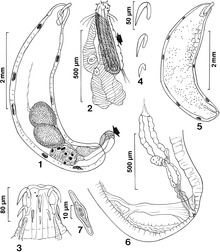Drosophila mettleri
D. mettleri was discovered in San Felipe, Baja California in October 1961 during an experiment where banana was used to attract several species of Drosophila.
The liquid found in rotting cacti patches serves as a nutrient source for D. mettleri larvae, despite it containing chemicals toxic to the intestines of other Dipterans.
An up-regulation in the genes encoding for xenobiotic resistance are attributed to the specialized and highly efficient detoxification ability of D. mettleri in comparison to other species.
[4] Similarities between these two species include large bodies, black carcasses, and thin, defined cheeks that stand in stark contrast to their elongated eyes.
Their inability to burrow into the soil has been shown to prove detrimental in increasing pupa survival, yet D. mettleri has an evolutionary advantage in their ability to exploit a niche environment for breeding.
The hypothesis that the necrotic tissue of cacti serves as a similarly protective environment as the soil of the Sonoran Desert for other species of Drosophila has been disproven.
Another physical geographic barrier is the Gran Desierto de Alter, a large sand dune between the peninsula and the mainland.
Studies of allozymes in D. mettleri and D. nigrospiracula show differences in nuclear markers that would otherwise suggest differentiation among the regions of the Sonoran Desert.
[10] The main host plants include the saguaro (Carnegiea gigantea), the cardon (Pachycereus pringlei), and the senita (Lophocereus schottii) cacti.
The largest necrotic patch sizes rank in order from highest to lowest: cardon, saguaro, organpipe, and senita.
D. mettleri exploits both necrotic patches and soil near rotting cacti; further, this species can thrive on a variety of hosts, leading to more dispersal of these flies under a given spatial region.
The unique ability of D. mettleri to detoxify the high concentration of alkaloids present in the soil surrounding cacti with rot spots enables adult females to lay their eggs and sustain their larvae in the same nesting area.
Other species of desert Drosophila that inhabit the same geographic region lack this ability and thus reduce the amount of competition females face in finding nesting sites.
One species (D. majavensis) is composed of adults who cannot withstand the high alkaloid concentration in cacti soil unlike the larva that is only slightly sensitive.
The juice found in the necrotic tissue of the cacti is also used as a feeding substrate when levels of exudates in the soil become low or scarce.
6–8 hours after the insemination process occurs, a female will get rid of any excess sperm and the material that was used as a copulatory plug by her mate.
The costs of having only one reproductive partner due to effects of the plug must be outweighed by the nutrient benefits gained by the ejaculated material.
The cost to benefit trade-off is dependent upon resource availability and is highly regulated by the distribution and growth of rot material.
The researchers concluded that the quick cycling of sperm in females explains why there may be frequent remating in this species both in the lab and in nature.
The significance of this behavior is that the arid conditions of the desert lead to extreme water loss in the cacti, and resulting liquid toxins trailing into nearby soil is concentrated to a magnitude other nectrotrophs cannot detoxify.
[21] Future generations showed transcriptional changes in genes triggering different metabolic pathways better equipped to detoxify the variant chemical environment of their host-cacti.
Drosophila species, including D. mettleri and others in its phylogenetic lineage, show predatory pressure by ectoparasitic mites that live in the necrotic rotting spots on desert cacti.
When D. mettleri feeds on these rots or breeds in these areas, they are parasitized by these mites which reduce their lifespans and hinder their reproduction abilities.
[22] To exploit the rotting liquid refuse of dying cacti, D. metlerri has been found to contain mutations leading to evolutionary adaptations.
This alteration is enough to lead to an up-regulation in gene expression causing a significant change in physical protein structure; the consequence is increased detoxification of toxins in host plants within the D. mettleri tested.
[3] A new model studies genetic isolation between species of cactophillic Diptera (D. mettleri and D. mojavensis) on the Catalina Islands off the Californian coast.
After comparing the genotypes of these species on the Catalina islands to other flies that use prickly pear cacti as their hosts, haplotype relationships among D. mettleri and D. mojavensis were found.
[26] Species of cacti that are larger and store more water, like the cardon and saguaro cactus, are able to retain cooler internal temperatures during periods of intense heat.
[11] D. mettleri is found most commonly near saguaro and senita cacti, characterizing their lower heat tolerance levels than other species of desert Drosophila.
Components leading to the toxicity of desert cacti include medium fatty acid chains, dihydroxy sterols, and senita alkaloids.




